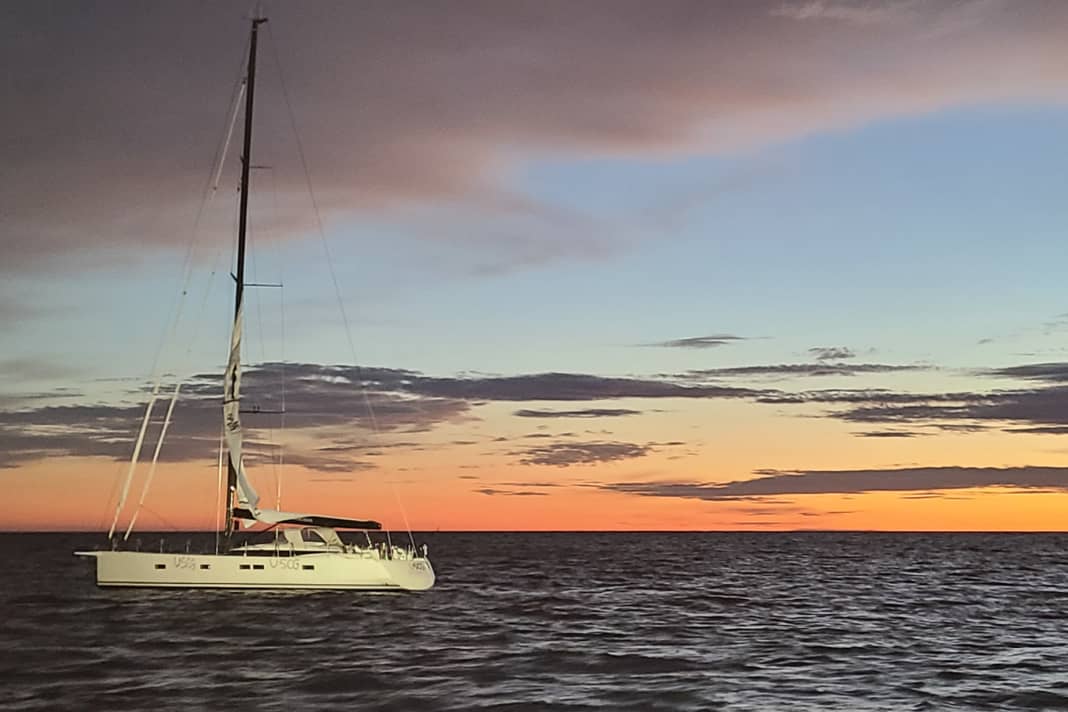





The accident that occurred on the 66-foot yacht "Escape" shook the international blue water scene last summer. Friends and family were left stunned. Within seconds of each other, first Annemarie A.-F. and then her husband Volker F. were hit so hard by the mainsheet, which was flapping in the storm, during a reefing manoeuvre that they both succumbed to their injuries on the way to hospital.
For a long time, it remained completely unclear what exactly had happened on the "Escape", which was en route from Bermuda to Nova Scotia in June 2022. Until suddenly, weeks later, a detailed log appeared on a US website. The events that led to the accident are recorded almost to the minute.
The information is largely based on the statements of two surviving crew members, whom the owner couple had taken on board for support, as well as on information from the US Coast Guard. The two crewmembers have not spoken publicly since and have not contacted the bereaved. The Coast Guard and other organisations involved in the rescue operations in the USA and Canada have also remained largely silent to this day. It is unclear whether this is out of consideration for the survivors or out of concern about possible claims for damages on the part of the bereaved. In any case, it is impossible to ask those directly involved about what happened before and on the night of the accident.
Nevertheless, this report and the statements of experts who were involved in the case allow us to cautiously categorise the events. This is because, in addition to the need for information, the review is also about what lessons can be learnt in order to avoid similar accidents in the future.
Pictures of other CNB 66






The chronology of the accident
The following account of the events that took place on the "Escape" is essentially based on the statements of the two surviving crew members and members of the US Coast Guard. Sheldon Stuchell wrote them down for the US sailing magazine "Bluewater Sailing". Stuchell, himself a bluewater sailor and director of the Salty Dawg Sailing Association, is the only private individual to whom the crew, whose names are not to be disclosed, confided. The times given in his report are local time.
9 June, 10.00 a.m.
The "Escape" leaves Bermuda as planned. After passing through the Town Cut Channel, the mainsail and genoa are set in 15 knots of wind - heading north. The 66-foot yacht has a powerful sail plan, which is supported by a carbon mast and a V-shaped carbon furling boom. In the first 24 hours, almost 200 nautical miles are travelled downwind. Three to four days to Nova Scotia. To secure the boom, a bull stander is used, which is led back to a winch in the cockpit. For training purposes, the second helmsman switches off the autopilot for a few hours on the first day to get a feel for the double rudder steering of the "Escape".
9/10 June, at night
During Volker F.'s watch, some squalls blow through and a sunburst occurs. F. then calls the crew on deck and assigns the stations. It is the first time they have had to reef as a team: Everything goes smoothly and quickly. Annemarie A.-F. is assigned the mainsheet, a crew member takes the helm and the skipper furls the mainsail. The mainsheet is attached in the cockpit in front of the steering wheels, runs up to the boom and down again to a block and from there to a central E-winch.
10 June, morning
Despite the stable situation, the crew ties in a second reef in 25 knots of wind. It is raining heavily and there is lightning in the distance. This time, too, the manoeuvre goes without a hitch. To reef the mainsail, Volker F. has to go forwards to the mast of the "Escape", where the electric winch for the main halyard and the electric and hydraulic controls for the furling boom system and the boom vang are positioned. As with most sailing yachts, the "Escape" must be turned into the wind to hoist or lower the mainsail. The second helmsman takes the helm for each reefing operation, while Annemarie A.-F. operates the mainsheet.
10/11 June
Over the next 24 hours, the conditions are much more moderate with aft winds of between 10 and 18 knots. We reefed out and even ran the engine for a few hours to provide support. Volker F. downloads the weather from PredictWind via Iridium Go and communicates with his weather router in Germany by e-mail. After two and a half days, the weather and the course of the trip are exactly as forecast; the "Escape" is well on schedule.
11 June, early evening
The weather forecast announces that the wind force should drop to 12 knots around midnight and continue to fall.
In view of several reefing manoeuvres previously carried out without any problems, the crew was not lacking in routine
11 June, 21.00 hrs
After sunset, a crew member takes over the watch from 9.00 pm to 1.00 am. With 18 to 20 knots of wind, the "Escape" makes a good nine knots under full sail. Volker F. goes below deck to rest up for his watch from 1.00 to 5.00 am.
11 June, 22.00 hrs
The wind picks up to 25 knots, reaching almost 30 knots in gusts. The crew and Annemarie A.-F. decide to wake her husband to reef again. The "Escape" is turned into the wind. The crew reefs routinely, as they have done five times now. Volker F. goes back to his cabin and the crew sails on for another hour or so.
11 June, shortly before midnight
Contrary to forecasts, the wind strength increases steadily and reaches 30 to 35 knots. The swell rises to a wave height of around six metres. At this point, the ship is in the Gulf Stream about 350 nautical miles south of Nova Scotia. The "Escape" surfs down the waves at 13 knots. Heavy rain sets in. Once again, the crew calls the skipper. As Volker F. rushes on deck, a 40-knot gust comes in. The ship threatens to shoot into the wind. The helmsman rudders hard and tries to hold course. The "Escape" is heeling so much that the railing is almost dragging through the water.
At the skipper's command, the mainsail is to be hoisted to the second reef. The engine is started and everyone takes up their positions. The helmsman steers into the wind. The waves, which are now almost eight metres high, crash over the deck, the bow rises and falls dramatically. The waves are also hitting the ship from different directions. Volker F. begins to furl the genoa before he tries to reduce the mainsail. His wife stands between the mainsheet winch and the helm and clears the mainsheet.
As the "Escape" comes into the wind, the helmsman notices that the boom is not centred as usual. During the previous reefing manoeuvres, the mainsheet had been hauled tight while the ship turned into the wind. Now, however, the boom begins to swing dangerously. Volker F. shouts instructions to his wife in German, which the non-German-speaking crew cannot understand. He then runs to the mainsheet to assist Annemarie A.-F.. His wife goes towards the winches on the port side to make way for him. As the "Escape" overtakes strongly in the wind, the boom strikes from starboard to port. The mainsheet hits Annemarie A.-F. in the back and knocks her to the cockpit floor.
Volker F. immediately runs to his wife. A crew member shouts a warning that the boom is swinging back. Shortly afterwards, Volker F. also hits the mainsheet and is thrown onto the starboard side. In the fall, he breaks his left leg below the knee several times. Within ten seconds, the two skippers were seriously injured. When the boom starts swinging back and forth again, the mainsheet breaks and, at an unknown point in time, the bullstay breaks. From then on, the boom swings uncontrollably from side to side.
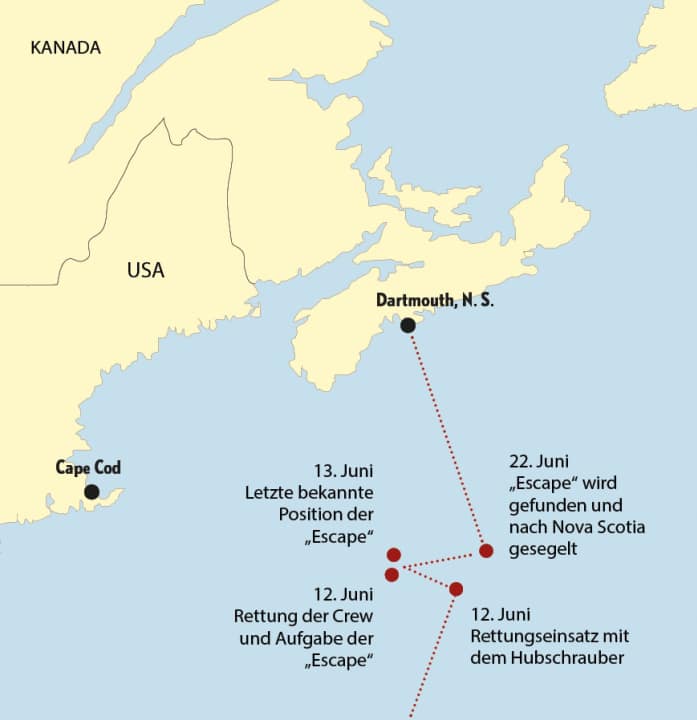
12 June, after midnight
The crew crawls into cover and pulls Annemarie A.-F. out of the danger zone into the cockpit seating area to bring her into as calm and stable a position as possible. Loose and broken lines whip around in the meantime. Volker F. is also pulled further out of the danger zone. One of his fellow sailors immediately starts to administer first aid to the skipper by taking a strap from a lifejacket and applying a tourniquet over his knee to stop the bleeding. The other man rushes down to fetch medical equipment and the Epirb. After the Epirb is released, the skipper's lower leg is bandaged and a Mayday call is then made via VHF channel 16.
As no ship is visible on the AIS and there is no response to the distress call, Volker F. also activates the satellite phone. When he manages to make contact with the coastguard, he hands the phone over to a crew member. From then on, the crew member handles all further communication from the companionway. An immediate medical evacuation of the injured is requested. A schedule of updates is also drawn up to keep the rescuers informed about the sea state, wind speeds, boat speed, coordinates and medical issues.
Meanwhile, the "Escape" is still out of control. The genoa and main are flapping wildly. The flapping boom lowers and first grazes the bimini until it finally crushes and deforms its metal frame. As the boom swings to port again and hits the shrouds, the crew manages to put the boat before the wind to keep the boom on the shrouds. With the wind now behind them, the boat gains a certain amount of stability, with the boom occasionally dipping into the waves and being thrown back against the shrouds.
12 June, approx. 1.00 a.m.
A crew member manages to crawl to the starboard winches and retrieve the torn genoa. Back at the helm, he steers before the wind for almost three hours. The other takes care of the skipper couple. The heavy rain, wind and swell continue. The "Escape" is now almost 400 nautical miles off the coast and is travelling at 10 knots. The wind and the Gulf Stream are also pushing the boat eastwards. Contact is maintained with the US and Canadian coastguards in Halifax via satellite phone.
Fortunately, a US Coast Guard patrol boat is currently underway off the north-east coast of the USA, albeit more than a day away from the "Escape". As it has enough paraffin on board, it is heading for a position where it can serve as a stopover for a rescue helicopter, which can refuel flying in both directions. With just one tank of fuel, the range of a helicopter would not be long enough to fly to the "Escape" and back again. Meanwhile, the crew apply another pressure bandage to Volker F.'s leg with the help of a toe bandage. Annemarie A.-F. is feared to have injured her spine. The skipper continues to provide as much assistance as he can, while the crew ensures that they both stay awake and receive water and mental encouragement.
12 June, 2.00 a.m.
The wind drops briefly to 15 knots. An attempt is made to reduce the mainsail on the downwind course. However, the wind pressure is too great, the sail jams in the furling boom after about one metre and cannot be furled any further. Hanging on to the mainsail, it is possible to pull down another metre of sail, further reducing the sail area. The ship is then steered into the wind at full engine power to temporarily secure the free-swinging boom. After several attempts, it is successfully lashed in a centred position with several lines. From this point onwards, the "Escape" is provisionally under control. The course is changed to the west, towards land. The US Coast Guard is informed of the new course.
12 June, 6.00 a.m.
A pre-deployed US Coast Guard C130 aircraft arrives on scene to establish clear communication between the Escape and the following rescue helicopter via VHF. On instruction, the deck is cleared and updates are sent on the sea state, wind speed, status of the boat, boom, mainsail and condition of the casualties.
12 June, 6.30 a.m.
The helicopter arrives with two divers on board. The boat engine is switched off for the safety of the divers and the bathing platform is lowered. The divers jump out of the helicopter, swim to the boat, climb aboard at the stern and begin providing medical care to the skipper and his wife. The seriously injured are then rescued with rescue baskets. The crew decides to stay on board the "Escape" so as not to delay the rescue operations. As the helicopter takes off, the crew is instructed to set a course of 300 degrees to meet the US Coast Guard ship. On the way there, the wind dies down and the swell calms down - much later than originally predicted.
12 June, 3.45 pm
The crew is informed by satellite phone that Volker F. and Annemarie A.-F. have succumbed to their serious injuries. The owner had died on arrival on the Coast Guard vessel, the skipper during the helicopter transport from the patrol boat to the hospital. Both are pronounced dead at the hospital in Massachusetts.
12 June, 4.45 pm
The "Escape" collides with the US Coast Guard ship around 350 nautical miles off the coast. The crew is transferred and the sailing yacht is abandoned at sea.
So much for the protocol. But there are still unanswered questions.
Was the weather really that harsh?
Assessments from weather expert Sebastian Wache




How did you prepare the skipper for the upcoming trip from Bermuda to Nova Scotia in terms of the weather?
We wanted to let the first tropical storm "Alex", which moved from the Gulf of Mexico towards Bermuda on 5/6 June, pass us so that we could sail with the moderate south-westerly winds of the receding storm depression to the north-east. The exact start time was then the responsibility of the skipper, depending on the local conditions.
Did you have any further contact after that?
After two days at sea, we provided a weather update, on the basis of which we suggested a course change to the north-west in order to avoid new lows coming from Canada as much as possible. The weather conditions were deteriorating at this point and we had forecast gusts of 30 to 35 knots, which could become stronger in showers or thunderstorms. The strategy was to push through on 11/12 June in order to get back into the high-pressure influence within a few hours.
Did the weather forecast give cause for concern?
The forecast conditions were challenging for an experienced skipper and crew, but gave no cause for concern. Volker F. had already mastered similar weather conditions with the ship during our collaboration. What's more, the "Escape" could have quickly passed through the forecast bad weather window.
What happened then from your point of view?
During the night of 11 to 12 June, the "Escape" came close to a marginal low, a small-scale area of low pressure that can develop from the turbulence of a main low. This resulted in shifting winds and superimposed wave patterns, coupled with showers, isolated thunderstorms and strong gusts. The Gulf Stream will also have contributed to the choppy seas. The terrible accident then occurred during the reefing manoeuvre.
Looking back: Was the weather underestimated?
As we had a lot of contact with the skipper couple, this tragedy was very close to our hearts. Afterwards, we worked through everything intensively and thought back and forth about what we could have done differently or whether we had overlooked something. However, the weather was exactly as we had predicted. Only the frequency of communication could have been increased, but that was up to the skipper, as it was also a question of cost. However, this would not have changed the timetable.
Can lessons be learnt from this tragedy?
Nowadays, professional weather routing is an important part of navigation on the high seas. We can provide good forecasts and tips for the route. Ultimately, however, the responsibility always lies with the skipper, who in this case did nothing wrong from a meteorological point of view.
Did the crew have enough experience?
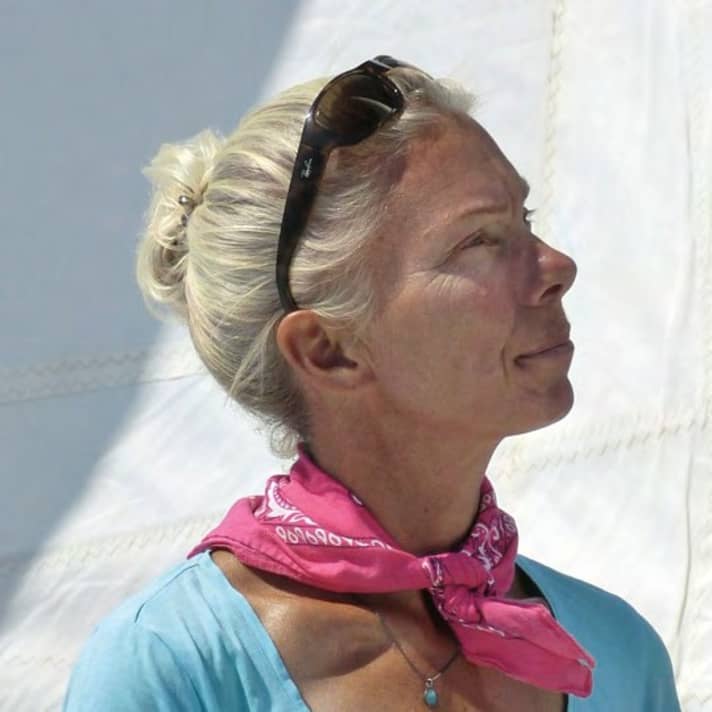
Volker was a very careful sailor." (Mareike Guhr)
"I got to know Annemarie and Volker during my coverage of the ARC 2019 in Las Palmas. We met again at the finish on Saint Lucia and became friends. They were a particularly hospitable and warm couple with lots of social contacts, and over the years we have always arranged to meet at different anchorages and shared some wonderful experiences.
In summer 2021, the two of them invited me on their 'Escape' for ten days. Together we sailed up the US east coast. I remember the ship as being quite massive and impressive, just manageable for a small crew. Volker was a very experienced and prudent sailor who knew how to handle his boat and always took excellent care of it. The accident was very close to my heart and it is still so incomprehensible that it is difficult to talk about it. Like everyone else, I am very disappointed that the survivors have never contacted the family to explain what happened and to avoid speculation. I suspect they don't want to make themselves vulnerable.
This chain of unfortunate circumstances should be a reminder to all sailors that a rescue on the high seas can be lengthy and complicated. I wish myself, the sailing community and of course the family that Annemarie and Volker will be remembered fondly - we miss them very much."
How was the "Escape" found?
On 14 June, the Grünwald boat insurance broker Bavaria, through which the yacht was insured, was informed of the accident. In co-operation with the Hamburg yacht consulting firm Zucker & Partner, the search for the abandoned "Escape" was coordinated. The first search operation carried out with a fishing trawler, which was based on information from the US Coast Guard, had to be cancelled after a week with no results. The search area proved to be much larger than expected.
PAL Aerospace, a Canadian company that has a department specialising in the drift parameters of icebergs, was then called in. Based on the last known position of the ship, the specialists calculated where the "Escape" was likely to have drifted after the skipper and crew were rescued and the surviving crew later transferred to the coastguard vessel. The trawler was given the coordinates and an aircraft was dispatched from St Johns, Newfoundland, to support the operation from the air.
On the night of 22 June, the salvagers actually came across the "Escape" - pretty much exactly where the drift specialists had expected it to be. The partly lowered mainsail was still set, and the Coast Guard rescuers had spray-painted the abbreviation USCG for United States Coast Guard on the stern ten days earlier. At dawn the next day, a crew of three set sail to inspect the boat and then transfer it to Dartmouth Cove in Nova Scotia. There it will be repaired and will then be included in the estate for the bereaved.
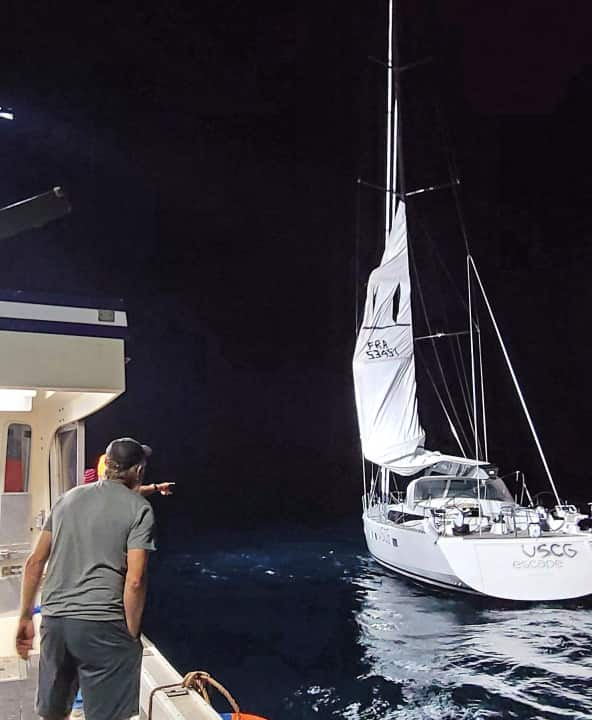
Was it bad seamanship?
After the transcript of the eyewitness report was published in the USA, discussions sprang up on the internet as to whether the crew of the "Escape" could not have carried out the reefing manoeuvre differently - more safely. Sailing downwind instead of steering the boat into the wind. The reasons for reefing with the main unfurled before the wind seem plausible: the ship remains on a stable course instead of pitching against the wind and waves. Neither the boom nor the jib pose a danger to the crew, especially when a bull stay is set. Even if the sail sticks to the shrouds or the spreaders, it can usually be pulled down piece by piece when the halyard is released. And even when sailing upwind, a reefing manoeuvre is possible if the pressure in the cloth is relieved by the downwash of the close-hauled genoa and the flapping of the mainsail.
On many smaller boats with conventional rigs, especially those without furling systems or without battens in the main, as well as on multihulls, these types of reefing are not entirely unusual. But not with the special furling boom system with which the "Escape", a CNB 66, was equipped. CNB Yachts representative Arno Kronenberg explains:
Reefing before the wind is not possible on this ship"
Kronenberg continues: "The luff of the mainsail is stuck in the groove of the mast without slipping. There would be so much friction and resistance in front of the wind that reefing would be impossible, even with an electric winch."
Even under ideal conditions, when the boat is upwind, reefing with a furling boom is not straightforward. Since, compared to a furling mast or genoa, it is not the lower luff that has to be furled, but the luff, which is three to four times as long, furling booms react much more sensitively to the furling action. The correct angle between the mast groove and the furling axis must be maintained. Otherwise the luff would either move aft too quickly or jam at the front.
The angles of 87 or 88 degrees quoted by some manufacturers are only a guide. The exact value varies from sail to sail and is determined during the installation of the system by means of furling tests. The kicker is then fixed in this position. This setting should be made by an experienced sailmaker or rigger. A Dyneema rope is also often spliced in to limit the rise of the boom. In heavy seas, it should also be fixed in place with a twist.
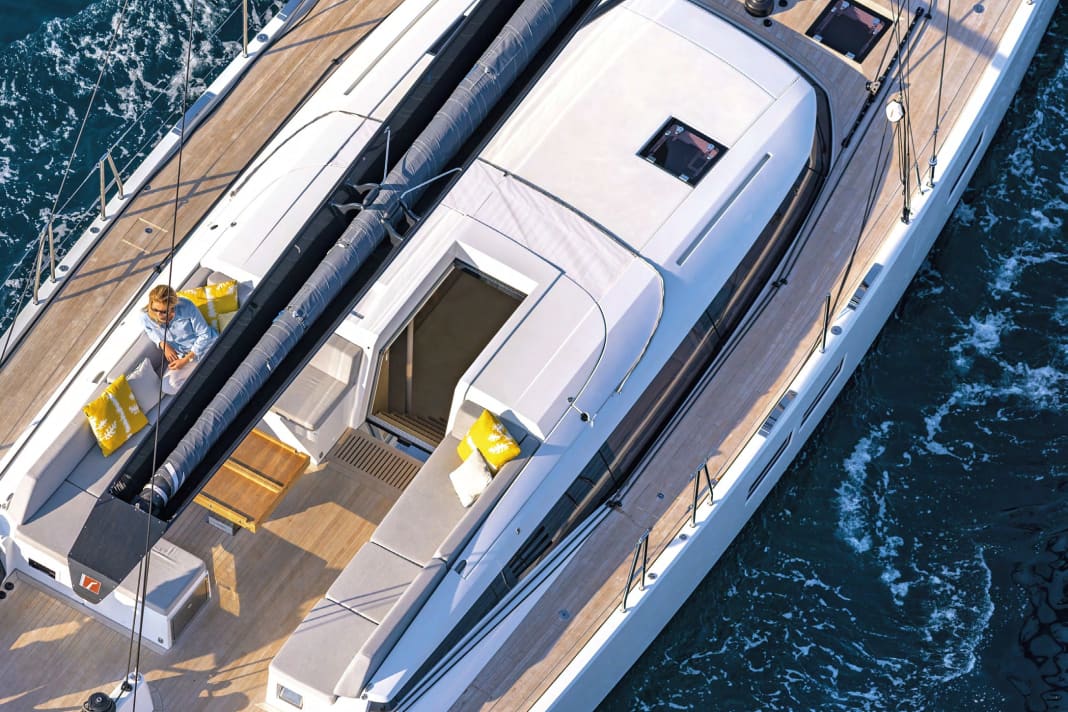


The hydraulic Furlfind system from Reckmann is ideal for very large yachts. This allows the kicker to be moved into the programmed furling position at the touch of a button. The boom must then be brought into this basic position before each furling operation. The setting of the backstay must also be taken into account. It influences the mast bend and therefore the angle to the boom. It should be set to the basic trim before furling.
Another point that has been discussed online is the mainsheet system positioned in the centre of the cockpit, the working area of which becomes a no-go zone during appropriate sailing manoeuvres. Kronenberg comments: "On boats of this size, the mainsheet must be locked in the cockpit. This creates a danger point where you must not stay during manoeuvres. A targa bracket would provide safety. However, this would result in the boom being moved further up, which would be accompanied by a loss of sail area and performance."
Could the accident have been avoided?
A jammed mainsheet, a defective winch or another cause? What exactly triggered the disastrous chain reaction that led to the skipper and his wife's doom will probably never be clarified. The opinions of meteorologists and the surviving crew members differ when it comes to assessing the weather conditions at the time of the accident. While the crew thought they were in a storm with eight-metre-high waves instead of an apparently expected calm, the weather routing team refers to a precisely forecast and somewhat less dramatic weather situation, which had also been discussed with the skipper and which he had intended to sail through.
However, the fact seems to be that Annemarie A.-F. was in a very dangerous place in the cockpit during the reefing manoeuvre. The mainsheet on a boat of this size can mutate into a deadly weapon. The crew's report does not answer why the boom was not centred and fixed or whether the sailor had problems doing just that. What remains is the realisation that, despite all precautions and careful preparation, there is no such thing as 100 percent safety on the water. And that problems can escalate at lightning speed in stressful situations.
Practice and routine help to ensure that manoeuvres are carried out safely. The prerequisite, however, is that the technology on board remains controllable even in extreme situations. On large modern yachts with their sometimes complex and powerful electrical and hydraulic systems, this can be a challenge for a cruising crew. But whether this applies to the skipper couple of the "Escape" or whether it was ultimately a chain of unfortunate and uncontrollable events - we don't know.

